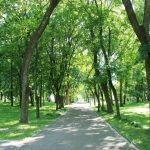Living closer to outdoor spaces and natural water may be better for your mental health, researchers say.
A new study finds that close proximity to nature may reduce an older person’s risk for serious psychological distress. That distress can lead to mild impairment of thinking and memory, as well as dementia.
The study is scheduled for presentation at a meeting of the American Academy of Neurology, online and in Boston, April 22-27.
“Since we lack effective prevention methods or treatments for mild cognitive impairment and dementia, we need to get creative in how we look at these issues,” said study author Solmaz Amiri, a postdoctoral research associate at Washington State University Elson S. Floyd College of Medicine.
“Our hope is that this study showing better mental health among people living close to parks and water will trigger other studies about how these benefits work and whether this proximity can help prevent or delay mild cognitive impairment and dementia,” she said in a meeting news release.
Mental health problems that require treatment and have a moderate to severe effect on a person’s ability to participate in work, school and social situations are considered serious psychological distress.
To study this, researchers used data from the U.S. Census and the Centers for Disease Control and Prevention to determine how close participants lived to so-called green and blue spaces.
While green space can include parks, community gardens and cemeteries, blue space is water bodies, such as lakes, reservoirs, large rivers and coasts.
The study included more than 42,000 people ages 65 and older who live in urban areas of Washington state.
Each answered questions about frequency of depression and anxiety symptoms using a 5-point scale. If someone never felt one of these symptoms, he or she would mark zero. If the symptom was constant, it would get a 4.
There were also questions on the severity of their feelings, including ones like how many days they were unable to work due to psychological distress, how many days their productivity was affected by distress, and how many times they sought professional help. Scores ranged from 0 to 24 with an average score of 2.
Participants who scored above 13 on the test were considered to have serious psychological distress. In all, 2% fit this description.
About 70% of participants lived within a half-mile of green space. About 60% were within a half-mile of blue space.
Those living within a half-mile of either had a 17% lower risk of experiencing serious psychological distress compared to those living farther away, the study found.
About 1.3% of those who lived within a half-mile of parks and water had serious psychological distress compared to 1.5% of folks who lived more than a half-mile away.
Researchers said one limitation of the study was that people self-reported their level of distress and may not have recalled or reported details accurately.
“Our hope is that this study may help inform public health policies in the future, from where residential facilities are located to programs to improve mental health outcomes of people living in long-term care centers or nursing homes,” Amiri said.
The preliminary findings were released Feb. 22. Research presented at medical meetings is considered preliminary until published in a peer-reviewed journal.
More information
The U.S. Forest Service has more on the wellness benefits of the outdoors.
SOURCE: American Academy of Neurology, news release, Feb. 22, 2023
Copyright © 2025 HealthDay. All rights reserved.



-300x169.jpg)












